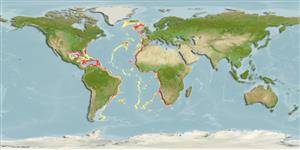Classification / Names
Nombres comunes | Sinónimos | Catalog of Fishes(Género, Especie) | ITIS | CoL | WoRMS | Cloffa
>
Lophiiformes (Anglerfishes) >
Ogcocephalidae (Batfishes)
Etymology: Dibranchus: Greek, di = two + Greek, brangchia = gills (Ref. 45335); tremendus: Named for its giant size and terrific spines, a species to be trembled at (= tremendus)..
Environment: milieu / climate zone / depth range / distribution range
Ecología
marino batidemersal; rango de profundidad 750 - 2300 m (Ref. 40826). Deep-water
Western Central Atlantic: Gulf of Mexico and the Caribbean Sea. Eastern Central Atlantic: Gulf of Guinea to Namibia.
Tamaño / Peso / Age
Maturity: Lm ? range ? - ? cm
Max length : 19.2 cm SL macho / no sexado; (Ref. 40826)
Short description
Morfología | Morfometría
Radios blandos dorsales (total): 4-7; Radios blandos anales: 4; Vértebra: 18 - 20. Tubercles without the radiating rows of spinules as seen in D. atlanticus (forming a shagreen). Spines of tubercles extremely long and stout , especially along sides of tail. Tubercles cover the surface of disk. Principal tubercles of ventral surface of tail very large and occupying entire ventral surface except for a few small tubercles in the median portion between anus and anal fin base. Cephalic lateral line count: subopercular usually 5 (4-5); preopercular usually 2. Firm skeleton; pliant skin, especially on ventral surface of disk. Fin without tubercles except at the extreme bases of the pectoral and caudal fins. Pectoral and pelvic fins both relatively long and slender in small individuals, shorter and broader with rays very fleshy in large ones (Ref. 40826).
Life cycle and mating behavior
Madurez | Reproducción | Puesta | Huevos | Fecundidad | Larva
Bradbury, M.G., 1999. A review of the fish genus Dibranchus with descriptions of new species and a new genus, Solocisquama (Lophiiformes, Ogcocephalidae). Proc. Calif. Acad. Sci. 51(5):259-310. (Ref. 40826)
IUCN Red List Status (Ref. 130435)
Threat to humans
Harmless
Human uses
Más información
Nombres comunesSinónimosMetabolismoDespredadoresEcotoxicologíaReproducciónMadurezPuestaAgregación para la puestaFecundidadHuevosEgg development
Age/SizeCrecimientoLength-weightLength-lengthLength-frequenciesMorfometríaMorfologíaLarvaDinámica larvariaReclutamientoAbundanciaBRUVS
ReferenciasAcuiculturaPerfil de acuiculturaRazasGenéticaElectrophoresesheritabilidadEnfermedadesProcesamientoNutrientsMass conversion
ColaboradoresImágenesStamps, Coins Misc.SonidosCiguateraVelocidadTipo de nataciónSuperficie branquialOtolitosCerebrosVisión
Herramientas
Special reports
Download XML
Fuentes de Internet
Estimates based on models
Preferred temperature (Ref.
123201): 3.3 - 6.5, mean 4.4 °C (based on 192 cells).
Phylogenetic diversity index (Ref.
82804): PD
50 = 0.5001 [Uniqueness, from 0.5 = low to 2.0 = high].
Bayesian length-weight: a=0.02291 (0.00925 - 0.05675), b=2.94 (2.72 - 3.16), in cm total length, based on LWR estimates for this (Sub)family-body shape (Ref.
93245).
Nivel trófico (Ref.
69278): 3.4 ±0.6 se; based on size and trophs of closest relatives
Resiliencia (Ref.
120179): Medio, población duplicada en un tiempo mínimo de 1.4-4.4 años (Preliminary K or Fecundity.).
Fishing Vulnerability (Ref.
59153): Low vulnerability (13 of 100).
